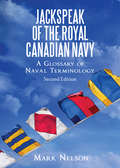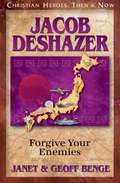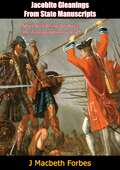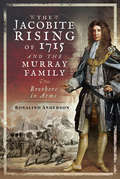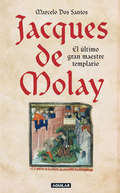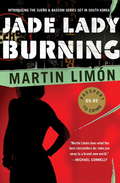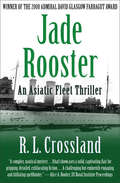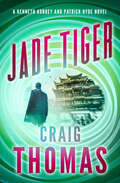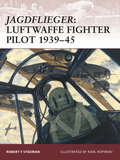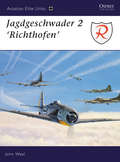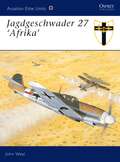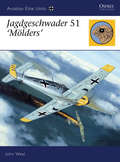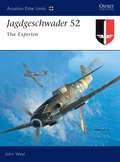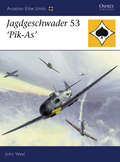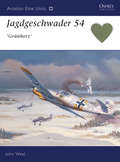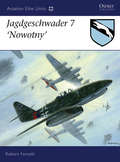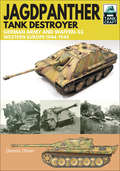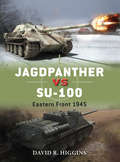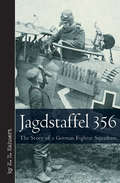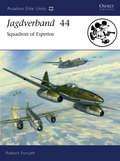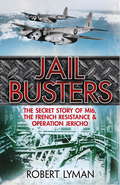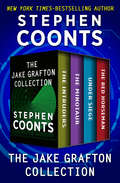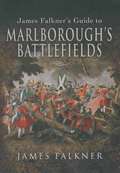- Table View
- List View
Jackspeak of the Royal Canadian Navy: A Glossary of Naval Terminology
by Mark NelsonPull up a bollard and get to know the colourful language of the Royal Canadian Navy. Do you ever get channel fever so bad only a great homeward bounders will cure you? Have you ever met Tug Wilson the brass-pounder, Dusty Miller the blanket stacker, or Nobby Clark the stoker? From aback to zizEX, the second edition of Jackspeak of the Royal Canadian Navy gives readers a chance to fill their boots with the colourful language of Canada’s senior service. Learn the difference between duff and no duff, box kickers and gut robbers, and Nelson’s blood and Neptune’s dandruff. Newly revised and expanded, with over 2,500 terms included!
Jacob Deshazer: Forgive Your Enemies (Christian Heroes Then & Now)
by Janet Benge Geoff BengeThree thousand feet above China, it was Jake's turn to jump. He slid his pistol, knife, and ration packets into the pockets of his leather jacket and edged toward the open hatch of the B-52 bomber. He checked the tension on the harness of his parachute, made sure the handle of the ripcord was free, and then began lowering himself out of the hatch and into the darkness. One of the famous Doolittle Raiders who first attacked Japan after the bombing of Pearl Harbor, Jacob DeShazer knew this one-way mission was dangerous. Indeed, it led to his capture as a prisoner of war. Beaten, malnourished, and alone in his cell, Jacob was given a Bible - and far away from home, this American soldier became a Christian. After the war, Jacob returned to Japan and served his former enemy for thirty years as a missionary. His testimony of forgiveness and reconciliation - of love over hate - inspires a powerful gospel message for our lives today.
Jacobite Gleanings from State Manuscripts: Short Sketches Of Jacobites; The Transportations In 1745 (classic Reprint)
by J Macbeth ForbesThe Jacobite rising of 1745, also known as the Forty-five Rebellion or simply the '45, was an attempt by Charles Edward Stuart to regain the British throne for his father, James Francis Edward Stuart.Charles launched the rebellion on 19 August 1745 at Glenfinnan in the Scottish Highlands, capturing Edinburgh and winning the Battle of Prestonpans in September. At a council in October, the Scots agreed to invade England after Charles assured them of substantial support from English Jacobites and a simultaneous French landing in Southern England. On that basis, the Jacobite army entered England in early November, reaching Derby on 4 December, where they decided to turn back.Similar discussions had taken place at Carlisle, Preston and Manchester and many felt they had gone too far already. The invasion route had been selected to cross areas considered strongly Jacobite but the promised English support failed to materialise; they were now outnumbered and in danger of having their retreat cut off. The decision was supported by the vast majority but caused an irretrievable split between Charles and his Scots supporters. Despite victory at Falkirk Muir in January 1746, the Battle of Culloden in April ended the Rebellion and significant backing for the Stuart cause. Charles escaped to France, but was unable to win support for another attempt, and died in Rome in 1788.-WikiIn the aftermath of the rebellion the British exacted swift and often brutal revenge for the uprising with confiscations and deportations to the colonies.
The Jacobite Rising of 1715 and the Murray Family: Brothers in Arms
by Rosalind AndersonA look at one of the most influential aristocratic families in Scottish history and their role in eighteenth-century politics.Based in Perthshire, the Murray family played an important role in all Jacobite rebellions, whether as rebels or supporters of the government. During the Great Rising of 1715, the head of the family, the Duke of Atholl, remained loyal to the Hanoverian government, but three of his sons were Jacobites. Two of these brothers then went on to play major roles in the 1719 Rising and in the more famous 1745.What led to their decision to commit to the Jacobite cause? A look at the earlier years of the Murrays at the end of the seventeenth and early eighteenth centuries sheds light on the family dynamics and helps explain how and why the brothers made the decisions they did. Traditionally the Murrays were thought to have perhaps made a conscious and pragmatic decision to have a foot in both camps, but the evidence presented here shows the brothers possessed a strong rebellious streak. Despite the heavily enforced regime of duty from their father and the Presbyterian piety of their mother, they refused to conform to their parents’ wishes and in varying degrees chose of their own volition, a different path to that expected of them.Set against the backdrop of social unrest and anxiety over against English influence in Scotland, these choices had a significant impact on the history of the family and, because of who that family was, a significant impact on the country.
Jacques de Molay: El último gran maestre templario
by Marcelo Dos SantosConozca en este nuevo libro de Marcelo Dos Santos, autor de El manuscrito Voynich, la odisea de Jacques de Molay, último gran maestre de la Orden de los Templarios. A principios del siglo XIV la sociedad europea veía el imparable avance de las órdenes monásticomilitares. Los principales de entre estos miles de monjes guerreros eran los Caballeros Templarios (orden fundada en la Jerusalén recién conquistada en la cruzada) quienes fundaron verdaderos imperios espirituales y económicos en las sociedades europeas de su época. De estricta observancia religiosa, obediencia ciega a los reyes y al papado, valor a toda prueba y un enorme espíritu de sacrificio, los Templarios estaban obligados a aceptar el combate de uno contra tres, no podían comprar sus vidas con rescates si caían prisioneros y se les exigía cumplir con otras severísimas reglas. Además de ello, debían someterse a los tres votos tradicionales de los religiosos cristianos: obediencia, pobreza y castidad. Encontraron tiempo aún para dedicarse a la producción agrícola, a la construcción de muchas de las grandes catedrales europeas y a financiar grandes proyectos y emprendimientos. A pesar de todas sus virtudes, sin embargo, un buen día cayeron en desgracia y fueron aniquilados.
Jade Lady Burning (George Sueño and Ernie Bascom #1)
by Martin Limón"The bizarre killing of Miss Pak should have belonged to the Korean police. But her amorous associations with American servicemen in Seoul also made her death the business of the U.S. Army's criminal investigation arm, of which Sgt. Ernie Bascom and Sgt. George Sueno were prized digits." "George is from East L.A., Ernie is from another planet. In the army, going after the truth is usually seen as a criminal waste of time, so they are well suited to the case. The Eighth Army command is anxious only to squelch the bad press, and the boys are really only interested in enjoying their tour of duty. The two of them know Korea, they like Korea (George even speaks the language), and they are all too happy to check the tawdry dives the woman had trawled for customers. Even if they don't find the perpetrator, the consequences are minimal." "There is something odd about the Korean cops' nervousness. Also, the actual killing is pretty heinous; the oddly trussed-up victim is little more than a youngster. Nobody can't die but there are ways no one should. The case gets to George and Ernie. They even work on it after hours. In their line, though, getting involved with a victim isn't smart because you increase tremendously the odds of becoming one."--BOOK JACKET. Title Summary field provided by Blackwell North America, Inc. All Rights Reserved
Jade Rooster: An Asiatic Fleet Thriller
by R. L. CrosslandTwo Americans, a naval petty officer and a shipping agent, are drawn into the undercurrents of early 20th-century Yokohama, Inchon, Manilla, and Shanghai as they investigate four grisly beheadings and a missing sailing ship. Smoldering insurgencies in Korea and the Philippines backlight USS Pluto’s course between violence, betrayal, and hope. Blending the historical authenticity of Patrick O’Brian with the crackling dialogue of Raymond Chandler, Crossland establishes himself as a unique voice in nautical fiction.
Jade Tiger (The Kenneth Aubrey & Patrick Hyde Series)
by Craig ThomasNew York Times–Bestselling Author of Firefox: At the height of the Cold War, the Berlin Wall may finally fall—but who&’s really pulling the strings? Sir Kenneth Aubrey remembers Wolfgang Zimmerman from a dramatic encounter back in World War II. In the intervening decades, Zimmerman has risen to become a top advisor to the West German chancellor. Thanks to Zimmerman, the prospect of a reunified Germany is now on the horizon. Until he falls ill during an overseas trade visit and begins to babble deliriously—in Russian. That, as they say, is a definite red flag . . . When Aubrey hears the story from a Chinese spy-turned-defector, he&’s unsure whether to believe Zimmerman could be secretly working for the Soviets. To untangle the truth, he and Hyde will have to go all the way to Australia—and face down a team of killers . . . Praise for Craig Thomas&’s thrillers &“High-octane.&” —Daily Express &“Will have you sweating bullets. Thomas misses no tricks, and tension is sustained from first page to last.&” —The New York Times Book Review
Jagdflieger: Luftwaffe Fighter Pilot 1939-45
by Karl Kopinski Robert StedmanOsprey's survey of German fighter pilots of World War II (1939-1945). Fighter pilots have always been held in the highest regard and the Luftwaffe Fighter pilots or Experten were undoubtedly the best pilots in the world, often racking up huge scores when compared to Allied fighters. It is for this skill, the sheer number of kills they obtained and their glamour that they are remembered even today. But what of the men themselves? It took a certain type of man to brave the skies in 1939-45, which were often more dangerous than the battlefields below and where a lone fighter pilot was often reliant on an aircraft that was frighteningly basic and fragile. Over the years much has been written about these Luftwaffe aces, but this book seeks to examine the lives of the ordinary men who took to the skies. These men all shared the same "aggressive spirit, joy of action and the passion of a hunter." Rich with fascinating first-hand accounts exploring every step of the fighter pilot's career from his enlistment, intensive training to his exploits in the Battle of Britain and on the Eastern Front, this book is an invaluable insight into the life of a Luftwaffe fighter pilot.
Jagdgeschwader 2: 'Richthofen'
by John WealTracing its roots to Manfred, Freiherr von Richthofen's 'Flying Circus' of WWI, the Jagdgeschwader 'Richthofen' is arguably the most famous fighter unit of all time. Designated JG 1 during the Great War, then disbanded following defeat, the Jagdgeschwader reformed as JG 132. By September 1939 the unit had become JG 2, seeing much action during the Blitzkrieg and Battle of Britain. This first in a new series focusing on elite fighter and bomber units, charts the career of JG 2 from its first aerial kills in 1939 to the destruction of its own Fw 190s in the face of the Allied advance in 1945.
Jagdgeschwader 27 'Afrika'
by John WealSynonymous with the Afrika Korps and the campaign in North Africa, JG 27 provided Rommel's army with fighter protection for virtually the whole 'roller coaster ride that was the war in the Western Desert from 1941-43. Formed in Germany on 1 October 1939 (with Adolf Galland as CO of I.Gruppe), JG 27 saw considerable action both during the Battles of France and Britain, downing 146 aircraft in the latter campaign alone. Sent to North Africa in April 1941, the geschwader had an immediate impact on the campaign, which had up until then been dominated by the Allies. The third volume in the Aviation Elite series on a German fighter geschwader, this book will once again prove popular with Luftwaffe enthusiasts and hobbyists alike.
Jagdgeschwader 51 'Mölders'
by John WealJG 51 were one of the Luftwaffe’s top wartime fighter units, yet their story has never been told in English. The unit’s history encapsulates the fortunes of the Luftwaffe’s fighter arm as a whole - the heady successes of the early months, the steady attrition and the growing strength of the opposition during the mid-war years, and the final chaos and collapse of the last days. But it is perhaps the details of the pilots who served with the unit that sets JG 51 apart. During the course of the war it numbered more Knight’s Cross winners among its ranks than any other. And it is their stories – their successes, exploits and eventual fates – which brings this history to life.
Jagdgeschwader 52: The Experten
by John WealJagdgeschwader 52 (JG 52) was the most successful and highest-scoring fighter unit, not just in Germany’s World War 2 Luftwaffe, but in the entire annals of aviation history. No other fighter group has ever come close to matching its staggering total of around 9000 enemy aircraft shot down in combat. And yet, because much of that combat took place over the tractless wastes of the Russian front, very little has been written in English about the exploits of this charismatic unit. This book provides a full combat history of JG 52 and its members, including the three top-scoring aces of all time, who claimed a total of 900 victories between them.
Jagdgeschwader 53 'Pik-As'
by John WealArguably the archetypal Luftwaffe fighter unit of World War 2, JG 53 aircraft were encountered on almost every fighting front from the first day of hostilities until the last. During almost six years of near-constant campaigning, JG 53 took a steady toll of Allied aircraft in every theatre it fought over. The variety of camouflage finishes worn by its machines -winter white, desert dapple and Reich's defence black - and the progression of variants are reflected in an eye-opening colour section. John Weal has spent several years researching in German archives and this, together with his personal contact with several veterans, results in an authoritative and human account of JG 53's long and eventful war.
Jagdgeschwader 54: 'Grünherz'
by John WealOne of the most successful of the high-scoring Luftwaffe Jagdgeschwader during World War 2, JG 54 ‘Grünherz’ (Green Hearts) was formed from three disparate fighter 'Gruppen' immediately prior to the Battle of Britain. Having enjoyed immediate success over the Channel and South-east England during the summer of 1940, the unit was transferred to the Eastern Front in the spring of 1941 in preparation for Operation Barbarossa - the German invasion of the Soviet Union. JG 54 would remain a Jagdwaffe stalwart in the east, flying firstly Bf 109Fs and then the Fw 190. By war’s end, the Geschwader’s pilots had claimed over 9500 kills, and produced over 100 aces. Men like Hans Philipp, Walter Nowotny and Otto Kittel are profiled in this volume, which reveals the struggle in the face of overwhelming odds that was the lot of the Jagdflieger on the Eastern Front.
Jagdgeschwader 7 Nowotny
by Robert Forsyth Jim LaurierWhen the revolutionary Messerschmitt Me 262 jet fighter first appeared in the skies over northwest Europe in mid-1944, it represented one of the greatest challenges to Allied air superiority. The first group to solely fly jet fighters, Jagdgeschwader 7 was tasked with wrestling back command of the skies. Put almost immediately into action, despite fuel shortages, poor training and problems with the jet engine, victories quickly followed against both US and British aircraft. By the end of the war, the Jagdgeschwader had claimed nearly 200 enemy aircraft destroyed in daylight bomber raids during 1945. This book follows the history of the JG 7 unit, examining how their courage, determination and the most advanced aircraft in the world were simply not enough to ensure victory. In the final section of the book Robert Forsyth details how JG 7 were eventually defeated by gradual losses, restricted operating conditions, lack of fuel and overwhelming Allied fighter strength.
Jagdpanther Tank Destroyer: German Army and Waffen-SS, Western Europe, 1944–1945 (TankCraft)
by Dennis Oliver&“First class illustration and a very effective text overview . . . covers the development, on the Panther chassis, of a very effective tank destroyer.&”— Firetrench Combining the destructive firepower of the 88mm gun with the outstanding mobility of the Panther series, the Jagdpanther is quite probably the best-known tank destroyer of the Second World War. In the vehicle&’s first action on 30 July 1944, three Jagdpanthers managed to destroy eleven British tanks in a vicious two-minute fire fight near the village of Les Loges in Normandy, cementing the Jagdpanther&’s reputation as a potent tank killer. In his fifth book in the TankCraft series, Dennis Oliver uses contemporary photographs and meticulously researched, superbly presented color and monochrome illustrations to tell the story of these heavy self-propelled antitank guns and the units which operated them in the German defense of the Western Front. As with all the books in the TankCraft series, a large part of this work showcases available model kits and aftermarket products, complemented by a gallery of expertly constructed and painted models. Technical details as well as modifications introduced during production and in the field are also explained giving the modeler all the information and knowledge required. &“Really interesting concept to combine historical, technical and modeling content in one book. Nicely illustrated . . . As a first Jagdpanther book for modelers seeking an economical source on models, accessories and paint schemes, this is valuable… Highly Recommended for Beginner to Intermediate builders.&”—AMPS
Jagdpanther vs SU-100
by David Higgins Richard ChasemoreThe culmination of big-gun German and Soviet tank destroyer design can be found in their clashes in Hungary in the spring of 1945. As World War II in Europe reached its end, armor development and doctrine had experienced several years of massively accelerated change, especially within the crucible of the Eastern Front. The German Jagdpanther and Soviet SU-100, both turretless tank destroyer designs based on a 'traditional' turret-tank chassis, were the culminating examples of how the progression of experience, resources and time constraints produced vehicles that were well suited for roles of defence and offence, respectively. The Jagdpanther represented a well-balanced solution and an excellent use of limited resources, while the SU-100 was a natural progression of the rudimentary but numerous SU-85.As the role of tanks broadened from essentially infantry support to anti-tank, armor thickness and armament increased to enable AFVs better to survive such encounters. Expensive and hard to upgrade with larger armament owing to the constraints imposed by turret-ring size and suspension, turreted tanks gave way in some contexts to new designs. The Soviets and the Germans alike found that more powerful guns could be installed directly into the hull, which in turn reduced the vehicle's silhouette, and allowed for increased armour protection for the weight. A rapid arms race resulted in the East with each side attempting to develop a battlefield edge, if only for a limited time.For the Germans the 8.8cm-armed Jagdpanther was intended for more defensive roles, such as ambushing or flank protection at long range where its superior sights and high-velocity rounds imparted an advantage. Its sloped armor and relatively light weight meant, unlike the more massive (and less practical) Jagdtiger (a Tiger II derivative), it could also operate in a more mobile capacity. Its superior optics offered key firepower advantages, but its origins in the overengineered Panther design meant it was susceptible to breakdown and mechanical problems.In contrast, the closest Soviet equivalent, the SU-100, was designed to operate alongside armor and mechanized forces in an offensive capacity, where its 100mm main gun would help counter heavier enemy armour when encountered. Although its speed and armour protection were comparable, the greater numbers fielded late in the war often proved decisive against an adversary increasingly forced to fight despite inadequate logistics and training. By this stage of the conflict, the Germans were forced to adopt ad hoc battle groups to coordinate their decimated parent formations' assets. The Soviets in turn possessed operational momentum, and were perhaps less concerned with tactical losses, in part as immobilized vehicles could be more easily recovered and reintroduced into combat.
Jagdstaffel 356: The Story of a German Fighter Squadron (Vintage Aviation Library)
by M.E. KaehnertA visceral and accurate firsthand account of flying with the Imperial German Air Force during WWI.The airborne fighting squadrons of the Imperial German Luftstreitkräfte—known as the Jagdstaffel, or Jasta for short—were a fearsome and elite force throughout the Great War. Though the entire force was dissolved and their aircraft destroyed by order of the Treaty of Versailles, the stories of the pilots remain in books like Jagdstaffel 356.Although the author has given this Jagdstaffel a fictitious number and changed the names of the pilots composing it, the vivid descriptions and accurate narrative have the genuine ring of truth. Anyone who has had experience of flying on the Western Front or who has studied it since will recognize this chronicle as factual. Many experts believe this work draws on the experience of the Bavarian Jasta 35, which flew against the British; however, whatever its real number may have been, the squadron depicted in Jagdstaffel 356 undoubtedly fought in the air over Flanders in 1918.
Jagdverband 44
by Jim Laurier Robert ForsythJagdverband 44 was formed in February 1945 on Hitler's orders, to fly the Me 262 "Stormbird", the world's first operational jet fighter, and demonstrate its superiority. The unit was led by the legendary Adolf Galland, who recruited some of Germany's leading aces into it, to the extent that it was said that the Knight's Cross was its unofficial badge. JV 44 engaged the US Ninth Army Air Force over Bavaria and, with its significant speed advantage and powerful armament of cannon and rockets, the Me 262 proved a formidable interceptor in the hands of its expert pilots. In its brief operational existence, never able to get more than six jets in the air at any one time, this small unit achieved approximately 50 kills in less than a month. Unfortunately for the German defensive effort (though Galland himself was glad not to have prolonged the war) there were not enough Me 262s to have any overall effect on the Allied air campaign.This book is a dramatic record of a highly individual unit and an exciting early chapter in the history of the jet fighter. Four of the world's ten surviving Me 262s are major attractions at flight museums in the USA and recently constructed replicas will soon be a feature of air shows around the nation and the "experten" aces of the Luftwaffe have an enduring fascination.From the Trade Paperback edition.
The Jaguar Hunter (Gateway Essentials #400)
by Lucius ShepardFourteen stories - including "Radiant Green Star", winner of the 2001 Locus Award for Best Novella - make up this classic collection. Leading off the book is the Nebula Award-winning title story, in which a poor Honduran hunter is coerced into tracking the forbidden "Black Jaguar of Barrio Carolina." Futuristic war, menacing wind spirits, parallel worlds, a six-thousand-foot dragon: this collection proves that Shepard is neither genre fantasist not strict realist, but one of the most intriguing writers we have today.
The Jail Busters: The Secret Story of MI6, the French Resistance and Operation Jericho
by Robert LymanIn the new year of 1944 the French Resistance in northern France was on its knees. Relentless attacks on its diverse and disorganised networks by the Gestapo and the Abwehr had put many of its best operatives in prison, or worse. But in the lead up to Operation Overlord, 'D Day', the Resistance had never been more important to the Allied war effort, and many groups were in the pay of Britain's Secret Intelligence Service, MI6. One such was organised by a patriot called Dominic Ponchardier. For months he had watched helplessly as his friends and colleagues had been swept up by the Nazi drag net, and cast into the old prison on the eastern outskirts of Amiens. In desperation he asked his MI6 handlers for help, and once London agreed it led to one of the most daring missions of the war. On the morning of 18 February 1944, nineteen Mosquito bombers flew at low level across the channel, skimming just above the ground to drop their bombs on sections of the walls of Amiens Prison. Hundreds escaped, scores of whom evaded recapture to continue the fight against Nazi repression. It was an epic of precision bombing, in which one of the most notable RAF heroes of the war, Group Captain Charles Pickard, lost his life. Robert Lyman's book reveals, from previously unseen sources, the full truth of MI6's involvement in the French Resistance, and narrates in vivid detail a stirring tale of courage and skill.
Jake: Amores de Redenção #2 (Amores de Redenção #2)
by Anna ScottJake é o cara mau, de mau humor. Hope é uma garota doce e generosa com um passado que prefere esquecer. Depois que ambos perdem um grande amigo, são jogados juntos de novas maneiras que nunca esperavam. Uma atração fervilhante aparece, mas quando Jake descobre que Hope está em sério perigo, ele não nada irá pará-lo de protegê-la. Ela quer ser forte, ela precisa ser independente. Ele quer proteger, ele precisa que ela precise dele. Como esses dois encontrarão o caminho?
The Jake Grafton Collection: The Intruders, The Minotaur, Under Siege, and The Red Horseman (Jake Grafton)
by Stephen CoontsThe hero of the New York Times–bestselling Flight of the Intruder is back in action—“Stephen Coonts, like Jake Grafton, just keeps getting better” (Tom Clancy). Navy pilot Jake Grafton took the fight to the enemy in the Vietnam War, winning the Congressional Medal of Honor and becoming a legend in the military community. But now he must navigate life both in the cockpit and in the halls of power as he finds himself on the front lines of a new kind of war . . . The Intruders: In this sequel to Flight of the Intruder, Grafton is stationed in the South Pacific on the USS Columbia, where his new mission is to educate an unruly group of Marines in the art of flying from an aircraft carrier. They better be fast learners, because they’ll have to work together to survive against an enemy unlike any they’ve ever faced. “In the realm of today’s military fiction, Mr. Coonts’s The Intruders is as good as they come.” —The Dallas Morning News The Minotaur: Grafton is heading up a top-secret stealth bomber program at the Pentagon when a series of mysterious deaths occurs, leading him on a manhunt within the US government for a Soviet mole code-named the “Minotaur.” If he can’t find the traitor, Grafton could lose far more than just his career . . . “Wildly inventive.” —Ocala Star-Banner Under Siege: In this New York Times bestseller, when a vicious drug lord is captured and brought to Washington, DC, for trial, his fanatically loyal private army prepares to launch an attack on the United States—and its president. The only man who can stop the bloodshed and take down the assassins is Jake Grafton. “Will keep you glued to your seat on a roller-coaster ride of adventure.” —USA Today The Red Horseman: As the USSR falls, newly appointed intelligence chief Jake Grafton knows that even as one threat falls, several more are waiting to get their hands on the former Soviet nuclear arsenal. And as he tries to stop a possible Armageddon, someone who is supposed to be on Grafton’s side is working to make sure he fails. “Quick-firing excitement, plot, and action . . . Coonts at his best.” —The Dallas Morning News
James Falkner's Guide to Marlborough's Battlefields
by James FalknerThree hundred years ago Queen Anne's Captain-General, John Churchill 1st Duke of Marlborough, led the Allied armies in an epic struggle against the powerful French forces of Louis XIV, in campaigns that stretched across wide areas of the Low Countries, France and Germany. Marlborough's victories at the Schellenberg, Blenheim, Ramillies, Oudenarde and Malplaquet are among the most remarkable feats in all of British military history. Marlborough broke France's military power for a hundred years. As James Falkner demonstrates in this, the first full-scale guide to the subject, the story of these famous campaigns makes compelling and exciting reading, and the sites associated with them are evocative places that can easily be visited today. His battlefield guide is essential reading for anyone who is keen to understand the military history of the era, and it is an invaluable companion for visitors to the many battlefields associated with Marlborough's triumphs.
